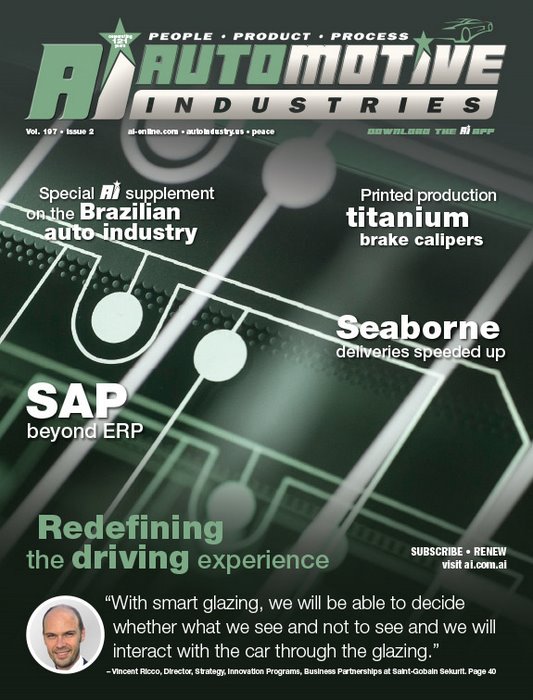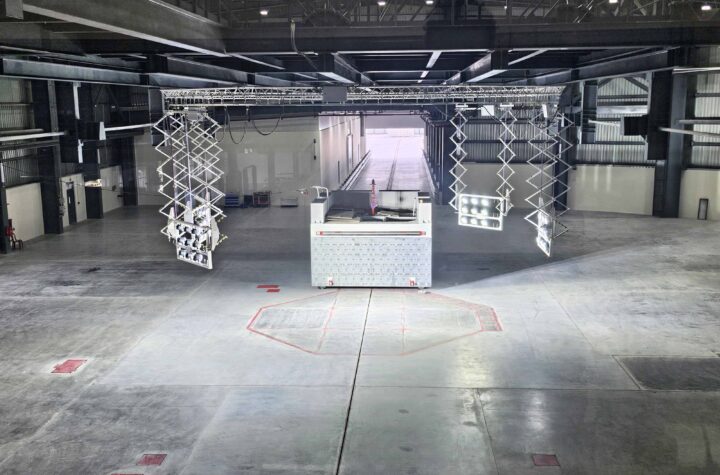
When drivers no longer have to concentrate on the road they will take more notice of their surroundings in the vehicle, and the levels of comfort and convenience. Most of the surfaces they look at will be glass in one form or another. Developments in the design of glazing systems are creating opportunities for OEMs to differentiate their vehicles and to add revenue-generating services while reducing their carbon footprint.
Automotive Industries (AI) asked Vincent Ricco, Director, Strategy, Innovation Programs, Business Partnerships at Saint-Gobain Sekurit, how the autonomous vehicle will change lifestyles.
Ricco: The experience of mobility will be redefined. The car will become a new living space, which means it will have to incorporate the comforts of the home or office. But, the real determinant of the success of autonomous vehicles will be safety.
AI: What role will glazing play in this evolution?
Ricco: Glazing makes up 40% or up to five square meters of the car surface. Today, the function of glazing is to protect people from what is happening outside the car, while at the same time providing acoustic and thermal comfort – and a view of the surroundings.
Tomorrow, with smart glazing, we will be able to decide whether what we see and not to see and we will interact with the car through the glazing. We could also reduce CO2emissions by incorporating solar cells in some glass surfaces. With autonomous vehicles every glazed component will also provide a potential surface for entertainment and augmented reality services.
AI: How do you see the transition of glazing from a protective shield to a number of integrated displays for ADAS?
Ricco: Today the car needs a windshield to protect passengers, but tomorrow the glass will also need to protect the cameras and sensors and other perception system of the car, many of which will need to be in potentially exposed points of the car, such as the roof. One way to protect a sensor on top of the vehicle is to place it inside the windshield and in the wiper zone in order to be able to clear dust and pollutants.
AI: What about radio waves outside the visible spectrum?
Ricco: Automotive glass today can incorporate a radio frequency antenna. In the future the glass will need to house 4G or 5G antennae to support vehicle to X and more. Every car will be a hub for connectivity and entertainment, and we will have to support Wi-Fi, Bluetooth and other forms of communication – while maintaining transparency.
AI: What new functions will be crucial for autonomous mobility?
Ricco: It will be necessary for the car to understand the state of the driver before handing control back. There will also be the need to communicate with pedestrians – which we do automatically with eye contact. Pedestrians, cyclists and other road users will need to know that the robot driving the car has “seen” them.
AI: How can ADAS warnings be seen by drivers from different angles of the vehicle?
Ricco: The human-machine interface (HMI) will need to be inclusive of as much of the population as possible. It must be able to interact with drivers aged 16 to 80, and from diverse backgrounds. Visual signals will need to be supported by audio and sensory alarms as part of a multi-modal approach. We know that 6% to 8% of the population cannot perceive depth, while another 8% are color blind. All these factors must be taken into account in the design of the safety features.
AI: What will be the applications for switchable glazing technology?
Ricco: Roller blinds look a little 20th century. In the 21st century the design aesthetic will be flush and switchable glazing.
This feature provides privacy on demand and also increases the feeling of cabin openness and head space. Smart glazing is
an opportunity to provide tailor-made experiences for different users. People will be able to choose what kind of experience and
comfort they want in the car and will be able to select between transparency or privacy according to their mood.
At the same time, smart glazing reduces CO2emissions as it provides the same screening from heat as a roller shutter. There
are fuel savings through weight reduction and the aerodynamic shape that flush glazing allows.
AI: What’s next for SGS?
Ricco:The future will be autonomous, electric, connected and sustainable. Sekurit will be definitely a part of it!
We have three main focus areas:
The first is to address safety challenges through supporting ADAS for autonomous cars by providing protection for the
different sensors and cameras
The second is to manage user the experience in the car and to support the market positioning and features of the OEM for a
particular model.
Thirdly, we want to provide glazing that ensures comfort through thermal and acoustic shielding, while giving vehicle
designers greater freedom.
Last, but not least, all this needs to be sustainable. We develop glazing systems which reduce weight, as well as those which can
harvest energy with built-in solar panels. They are also developing a greater understanding of the life-cycle of glazing in order to
ensure sustainability and help OEMs to manage CO2emissions.
Ensuring that we meet these needs is an internal dedicated team called Glass Future. It is responsible for developing glazing systems which reduce weight, as well as those which can harvest energy with built-in solar panels. They are also developing a greater understanding of the life-cycle of glazing in order to ensure sustainability and help OEMs to manage CO2 emissions.
The five levels of autonomous driving
- Level 0: Automated system issues warnings and may momentarily intervene but has no sustained vehicle control.
- Level 1 (“hands on”):The driver and the automated system share control of the vehicle. Examples are adaptive cruise control (ACC), and parking assistance. The driver must be ready to take full control at any time.
- Level 2 (“hands off”): The automated system takes full control of the vehicle (accelerating, braking, and steering). The driver must monitor the driving and be prepared to intervene if the automated system fails to respond properly.
- Level 3 (“eyes off”): The driver can safely turn their attention away from the driving tasks, and text or watch a movie. The vehicle will handle situations that call for an immediate response, like emergency braking. The driver must be prepared to intervene within the time specified by the manufacturer when called upon by the vehicle to do so.
- Level 4 (“mind off”): As level 3, but no driver attention is ever required for safety. The driver may safely go to sleep or leave their seat.
- Level 5 (“steering wheel optional”): No human intervention is required or possible. An example would be a robotic taxi.









More Stories
MESSRING completes new crash test facility for Mahindra in India
ROHM Develops an Ultra-Compact MOSFET Featuring Industry-Leading* Low ON-Resistance Ideal for Fast Charging Applications
More than 30 of the top 50 global suppliers have production facilities in Turkey